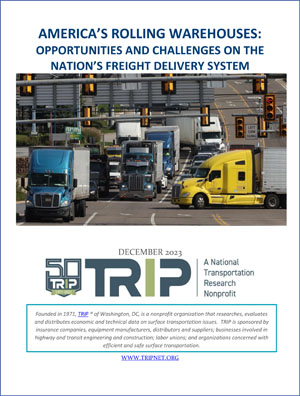When it comes to keeping truck freight moving efficiently, Ohio will have its hands and roads full over the next 20 years according to estimates by The Road Information Program (TRIP).
Prior to its January report, “Keep Ohio Mobile: Providing a Modern, Sustainable Transportation System in the Buckeye State,” the national transportation research group looked at the challenges facing the nation when it comes to the demand for faster freight delivery. The December 2023 TRIP report, “America’s Rolling Warehouses: Opportunities and Challenges on the Nation’s Freight Delivery System,” looked at U.S. freight transportation trends – which in 2022 recorded the highest logistic costs at $2.3 trillion.
“TRIP’s latest report on Ohio’s transportation system (see Keeping Ohio Mobile article, page 10), along with TRIP’s recent national freight transportation report, shows the significant challenge that Ohio faces in providing a reliable, safe and well-maintained freight network,” said TRIP Executive Director Dave Kearby.
“Ohio continues to make progress in improving the reliability and safety of its most critical highways, but the state’s ability to fund critically needed projects is being undermined by significant highway construction inflation that has reduced the impact of recent increases in state and federal transportation funding.”
The “American Rolling Warehouses” report examined how the movement of freight in the U.S. is changing due to the increase and changes in vehicle autonomy, manufacturing, warehousing, supply chain and the way consumers are utilizing e-commerce and faster delivery methods.
According to TRIP, COVID-19 rapidly accelerated growth in retail e-commerce, as stay-at-home policies during the pandemic changed the ways consumers made purchases. From the first quarter of 2020 to the second quarter of 2023, U.S. e-commerce sales increased from $160 billion to $278 billion – a 73% increase. Buying online along with technological advances in vehicle autonomy, manufacturing, warehousing and supply chain automation has also affected movement of the nation’s freight.
While there are several ways freight is moved in the U.S., trucks – i.e. roads – carried 72% by value and 64% by weight in 2022. With TRIP estimating a 93% increase in value and 47% by weight of all freight over the next approximately 30 years, expect the nation’s roads to become even more essential – and busier.
According to TRIP, “In 2022, Ohio’s freight system moved 980 million tons of freight, valued at $1.1 trillion – the seventh-largest value of freight moved of all states. From 2022 to 2050, freight moved annually in Ohio by trucks is expected to increase 56% in weight and 99% in value (inflation-adjusted dollars), the 10th-highest projected increase in the nation.”
The TRIP report also found 15% of travel on Ohio’s Interstate highways and 24% of travel on its rural Interstate highways is by combination trucks – the 14th-highest share in the nation.
While the quantity and value of goods being shipped have risen to unprecedented levels, so has traffic congestion – which has increased the cost of moving freight and in turn the economic competitiveness and efficiency of businesses that require reliable, affordable freight transportation. Traffic congestion, which led to commercial trucks being stuck in traffic for 1.5 billion hours in 2022, resulted in $94.6 billion in additional operational costs to the trucking industry.
The increase in truck traffic has also led to more fatalities on U.S. roads. TRIP reports that from 2017 to 2021, fatalities in large truck-involved crashes increased 18%, from 4,906 to 5,788. Approximately five-of-six people killed in crashes involving a large truck were occupants of the other vehicle involved in the accident, pedestrians or bicyclists. While large trucks account for 5% of all registered vehicles and 10% of all vehicle miles traveled (VMT) annually, 13% of traffic fatalities occur in traffic crashes in which a large truck was involved. The most-frequent event prior to fatal crashes between large trucks and another vehicle is the entering or encroaching into a large truck’s lane by the other vehicle. In Ohio, from 2017- 2021, an average of 177 people were killed each year in collisions involving a large truck, approximately 15 annual fatalities per-100-million population – which tied for 24th-most of any state.
 TRIP’s report concludes with recommendations to upgrade freight transportation by:
TRIP’s report concludes with recommendations to upgrade freight transportation by:
- Increasing capacity on the nation’s freight transportation system, particularly at major bottlenecks
- Improving the reliability and condition of intermodal connectors between major highways and rail, ports and waterways
- Further developing vehicle autonomy and warehouse automation
- Improving roadway safety and providing additional truck parking spaces to ensure adequate and timely rest for drivers.
- Providing funding for freight transportation improvements that is substantial, continuing, multimodal, reliable and, in most cases, specifically dedicated to freight transportation projects.
- Providing a permanent, adequate and reliable funding fix to the federal Highway Trust Fund as a critical step towards funding a 21st century freight transportation system.
TRIP’s “America’s Rolling Warehouses: report, which includes data for all 50 states, is available at https://tripnet.org/reports/americas-rollingwarehousesopportunities-and-challenges-withthe-nations-freight-delivery-systemdecember-2023/.

